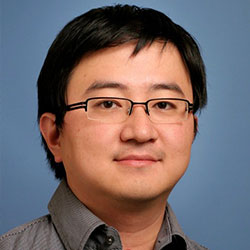Flexing the Lifespan of AI-Enabled Electronic Devices
A team led by Professor Qi Zhu received an NSF Design for Environmental Sustainability in Computing award to extend hardware life and reduce waste and emissions
When it comes to electronic waste, “WEEE” is not an exclamation of excitement but rather an indicator of a global crisis. “Waste of Electrical and Electronic Equipment” is steadily increasing as technology advances: about 50 million metric tons of WEEE are generated annually worldwide, which is expected to increase to 111 million tons per year by 2050.
While retrofitting devices, from cell phones to vehicles, faces many challenges – it is often easier and more affordable to buy new – researchers see promise in novel machine learning-enabled cyber-physical systems (LE-CPSs) to build flexibility into hardware and thereby increase lifespan, reduce e-waste, and improve sustainability.
 To explore this potential, Northwestern Engineering’s Qi Zhu and researchers at the University of Pittsburgh were awarded $600,000 from the National Science Foundation Design for Environmental Sustainability in Computing (DESC) program. The team is one of 25 research teams receiving a combined $13 million to develop technological innovation and environmental sustainability in computer systems.
To explore this potential, Northwestern Engineering’s Qi Zhu and researchers at the University of Pittsburgh were awarded $600,000 from the National Science Foundation Design for Environmental Sustainability in Computing (DESC) program. The team is one of 25 research teams receiving a combined $13 million to develop technological innovation and environmental sustainability in computer systems.
Zhu, who heads the Design Automation of Intelligent Systems Lab, is the principal investigator (PI) of the DESC project, titled “FLEX: Building Future-proof Learning-Enabled Cyber-Physical Systems with Cross-Layer Extensible and Adaptive Design” (awards 2324936 and 2324937).
Zhu is an associate professor of electrical and computer engineering and (by courtesy) computer science at the McCormick School of Engineering.
Co-PI Jingtong Hu is an associate professor of electrical and computer engineering at Pitt’s Swanson School of Engineering and the co-PI on a second DESC award to develop “REFRESHed” computer chips.
“When Alan Moore, the co-founder of Intel, first postulated in 1965 that the number of transistors on computer chips would double every two years, he thought it would remain constant for at least a decade,” Zhu said. “Here we are almost 60 years later, and this trend continues while devices become more powerful and energy efficient. And yet, if we look back over those six decades, we see that it has been easier and cheaper to throw technology away or recycle what components we can, even though the overall device is still in good shape. From phones and computers to other technology, we can no longer economically or environmentally afford to cut short their realistic lifespans.”
Zhu noted that retrofitting technology could have tremendous benefits to society. In the case of a smartphone, extending its usage by just one year can cut CO2 impact by 31 percent. However, in their proposal, Zhu and Hu noted that retrofitting could be quite challenging, “especially for emerging LE-CPSs such as autonomous vehicles, medical devices, and robots, which often operate within a constantly changing physical environment, have limited resources and stringent timing requirements, and employ complex and resource-consuming machine learning techniques.”
“Swapping out parts for a retrofit is not always economical; however, if we design flexibility into the software and hardware architecture, we can create a more adaptive device that can increase its own lifetime,” Hu said. “This is where FLEX comes into play – “future-proofing” a learning-enabled device by using a cross-layer framework that on the one hand makes the existing architecture more accommodating to changes, and on the other hand makes their machine learning functionality more adaptive with respect to resource limitations and environment changes.”
Zhu added that the NSF award will enable them to explore multiple designs of neural networks to provide a more adaptive system, and to develop on-device continual learning algorithms that allow a system to accommodate changes without physically swapping out hardware.
“Although recycling programs for technology have improved over the past few years, there is still so much hardware that is illegally junked, incinerated, or dumped in third-world countries without the infrastructure to safely process it,” Zhu said. “If we can integrate flexible adaptivity into our AI-enabled devices, we can reduce this waste and make our technology more sustainable. More broadly, we hope that this project can be a first step for us to explore environmentally sustainable ways to build and use future generation AI systems.”
According to the NSF, the Design for Environmental Sustainability in Computing (DESC) program “aims to address the substantial environmental impacts that computing has through its entire lifecycle—from design and manufacturing, through deployment into operation, and finally into reuse, recycling, and disposal.” Margaret Martonosi, NSF CISE leader, also highlighted the award in her keynote address at the prominent International Symposium on Computer Architecture this past June.
